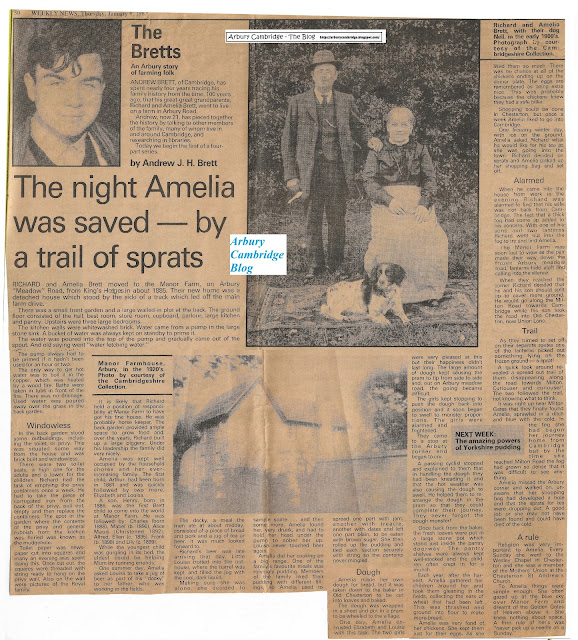Inspired by the 1981 book, Arbury Is Where We Live! Andy Brett set out to research his Arbury family history. Andy's great grandfather, Henry Brett, was born at King's Hedges in 1886, north of what is now the guided busway (the modern and inappropriately named "King's Hedges" has an Arbury history and is not actually in King's Hedges), the same year his family moved to the Manor Farm on Arbury Road.
'I wasn't aware of the exact year when I wrote the articles,' says Andy. 'So the new information needs to be inserted in places against the information I had at the time. But the vast majority of the information is unchanged. The Brett family came from Histon and Impington. They lived at King's Hedges for a few years. It was a small farm of 58 acres. Then they moved to the Arbury Manor Farm, which was 245 acres. I have also since discovered that Richard Brett, my great-great grandfather, was definitely, not 'probably', horse keeper at the Manor. It is listed on a census return. He was amazing. His appetite for work was incredible - he worked for himself and others, held down several jobs at a time - never enough minutes in the day - but never complained!'
Bretts' progress... Beginning at Histon and Impington, the family lived at the (real, historical - not electoral ward) King's Hedges, then moved into Arbury.
The family's home at Manor Farm was opposite the modern day Arbury Town Park and Arbury Community Centre, home of the Arbury Carnival since 1977. It was then the Manor Farm's Stable Field.
Brought up on tales of the Manor Farm, Arbury Meadow Road, the Arbury Meadow, Arbury Field, Boy's Pit, the Mere Way, the ghosts of Arbury Camp, Milton Road, Chesterton village ('Old Chesterton'), New Chesterton and much more, Andy was captivated by Arbury Is Where We Live! in 1981 and set to, collecting up family memories, maps, birth certificates, census returns, photographs and much more.
It never struck Andy at the time that his growing up in Cunningham Close, South Arbury, in the 1970s would one day be history too!
In late 1986, Andy wrote four articles for the Cambridge Weekly News, which appeared in early 1987.
He would like it to be known that the clever title, An Arbury Story of Farming Folk, a play on the the BBC Radio serial's The Archers tag-line 'An Everyday Story of Farming Folk', was added by an anonymous sub editor at the Cambridge Weekly News.
'I wish I'd thought of it!' he says.
We love this series. It combines amusing family incidents with the history and living conditions of the time - everything from tales of the Ghosts of the ancient Arbury Camp, to somebody being saved from death in a ditch by a trail of sprats, to pumping up water, keeping a piggery and facing the grim realities of the First World War and Sleeping Sickness.
Anyway, here is the first part: what were living conditions like at the Manor Farm from the 1880s to the 1920s? Amelia is saved by a trail of sprats on the Milton/Ely Road, and Elizabeth and Louisa face the Dough Monster in Arbury Road...
Right click on the image, then click on 'open link in new window' for a large, readable view and download if wanted to keep.
Part two is here. As historian Sallie Purkis, of 'Arbury Is Where We Live!', said in 1983, 'The establishment of an Arbury Archive has barely begun.' Further work has been undertaken since, and it is wonderful to be able to put some of this work online.


.jpg)

Comments
Post a Comment